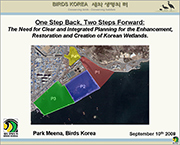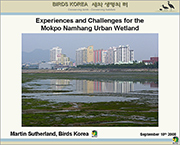From Birds, to Conservation, to Ramsar
An Introduction to The Mokpo Namhang Urban Wetland Project:
From Birds, to Conservation, to Ramsar
The Mokpo Namhang Urban Wetland is a beautiful, small wetland located in Mokpo City, comprised of an open estuary, a freshwater reed-bed, and two areas of wetland enclosed by seawalls. The Mokpo Namhang Urban Wetland with its four component parts has great conservation potential and potential for environmental education and eco-tourism, but much of the area is heavily disturbed and the enclosed areas are threatened by further development (apparently including in-filling with sand). This section of the Proceedings aims to introduce: the site; the conservation context of this project and symposium; and the Birds Korea project to “Establish preliminary guidelines, processes and basic designs for the enhancement, restoration and Wise Use of the Mokpo Urban Wetland.” All of this is presented against the background of the upcoming Ramsar Convention conference in Changwon City (between October 28th and November 4th). Holding this major inter-governmental conference in Korea provides an excellent opportunity to raise public awareness and win support for wetland conservation throughout the nation, including here in Mokpo City.
The Mokpo Namhang Urban Wetland
The Mokpo Namhang Urban Wetland (with a core area of approximately 50 ha in total), is a small, relict area of inter-tidal and modified wetland located in the outer part of the once-extensive Yeongsan Estuary, in Mokpo City. It consists of a buffer zone (in need of more precise delineation, but containing open sea areas, and patches of parkland) and four core wetland areas (P1-P4):
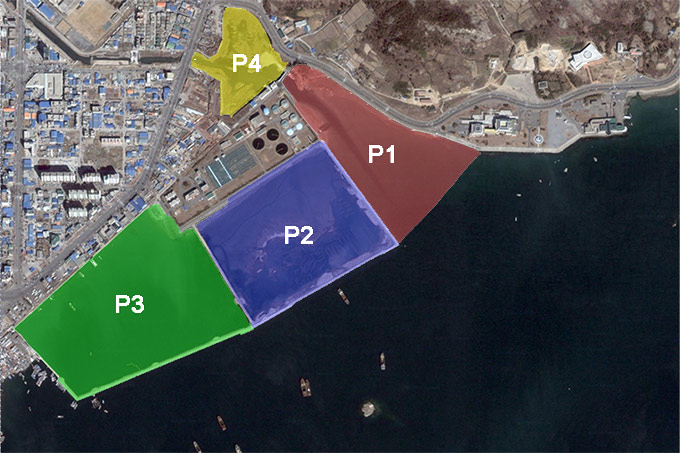
(P1) 9.5 ha estuarine area of near-natural area of sea shallows, and inter-tidal flats, with small patches of natural/near-natural vegetation fed by one or more highly modified freshwater sources;
(P2) An approximately 17 ha area formerly intended for reclamation with limited tidal movement now comprised of a brackish lagoon with shallow islands and areas of open mud;
(P3) A further c.20 ha area of deeper water, separated by and also contained within reclamation walls; and
(P4) A reed bed and freshwater stream occupying c. 2.5ha, separated from P1 and by a sluice-gate.
The hinterland has a highly-developed infrastructure of roads and buildings, while seaward adjacent areas are used by marine traffic (including fishing boats and ferries). All four parts of the site are essential to the maintenance of the biodiversity and other values of the wetland, while a future Management Plan also needs to consider in detail both landward and seaward areas.
There is at present multiple use of the wetland, with conservation-related activities including research, bird watching and occasional environmental education programs (conducted by Mokpo Natural History Museum and Birds Korea). The site is also used for recreation by many local people (for fishing, walking/exercising), and e.g. for storage of fishing equipment. The site can be considered a highly-accessible and representative Yellow Sea estuarine wetland, in an area of very high human population and pressure.
The Wetland’s Present Values
The Mokpo Namhang Urban Wetland, like many wetlands, has multiple values, including for biodiversity, for fisheries, for maintaining water quality, for recreation and for environmental education. All of these values would be greatly enhanced through appropriate management.
The wetland, even in its present condition, is important for biodiversity, and survey confirms that the site is nationally important for waterbirds. Since 2006, 124 bird species have been recorded in the wetland, including at least two globally-threatened species (Chinese Egret Egretta eulophotes and Saunders’s Gull Larus saundersi) and six National Natural Monuments. The vast majority of bird species using the site are migratory, and to date 66 shorebirds marked with overseas leg-flags have been seen at the wetland. This confirms the Mokpo Namhang Urban Wetland’s importance to international conservation efforts.
The popularity of the wetland with recreational fishers indicates that the site is important to people and also probably to fisheries in a wider area (many species of commercially valuable fish need shallow sea and tidal-flats for egg-laying or during part of their life-cycle).
While more research is needed, the wetland also appears to play an important role in helping to maintain water quality. The reed-bed (P4) will help in the reduction of the level of land-derived pollutants reaching the sea, as will the open areas of shallow water within the open estuary (P1) and the two enclosed parts of the site (P2 and P3).
The wetland is also already important for environmental education and potentially for eco-tourism – two values that could be considerably enhanced through appropriate site management, including improved zoning.
In summary, the Mokpo Namhang Urban Wetland is exceptional in containing complex wetland types within a very small area, located within a major city. It has enormous potential value for Mokpo citizens (as a semi-natural open space and as an outdoor classroom), and should support the city’s efforts in achieving national and international goals for sustainable development. The wetland clearly has the potential to demonstrate the excellence of Mokpo to a local, national and international audience.
The Wider Conservation context
Wetland conservation is mandated through national laws and through international conventions and agreements. The Ramsar convention is the convention for wetlands. To date, 158 national governments have signed on to the Ramsar Convention, including the Republic of Korea. Joining the Ramsar Convention in 1997 stimulated the passage of the domestic National Wetlands Conservation Act (1999), which in turn led to increased survey of wetlands and their values nationwide. Since joining the Ramsar Convention, the national government has started “to review and modify existing policies that adversely affect intertidal wetlands, to seek to introduce measures for the long-term conservation of these areas” (Ramsar Resolution 7.21), and has announced that:
“The Republic of Korea government believes that intertidal mudflats should be preserved.” (ROK government statement, Ramsar 35th Standing Committee meeting, February 14th 2007).
Further, the Ministry of the Environment and the Ministry of Land, Roads and Maritime Affairs have also together established a National Wetland Management Plan (2007-2011) to:
“minimize the damages and losses of wetlands; to restore wetlands to the original state; to manage protected wetlands, giving priority to those with high-scenic and biodiversity values; and to improve the livelihoods of residents…The Plan aims to prohibit any further damages to and losses of wetlands as much as possible, restore natural wetlands to their original state, give special attention and care of protected wetland areas with excellent biodiversity and scenic values, and to strengthen the wellbeing and livelihoods of local residents. In particular, the Plan incorporates the wetland-related targets and actions of WSSD (World Summit on Sustainable Development) Plan as part of the National Strategy for Sustainable Development (2006 – 2010) drafted by the high level Presidential Committee on Sustainable Development.”
(online at: 2008 National Report on The Implementation of the Ramsar Convention)
Birds Korea believes (along with a wide range of other stakeholders) that the Mokpo Namhang Urban Wetland should be conserved, in line with the aims of the National Wetland Management Plan and the National Strategy for Sustainable Development. Successful conservation of the wetland by necessity includes the immediate cancellation of destructive development plans that would cause “damages and losses of wetlands” (such as in-filling part of the wetland), and also gradual enhancement and restoration of the wetland to increase “scenic and biodiversity values and…improve the livelihoods of residents.”
We also believe that the hosting of the Ramsar Convention will focus the eyes and minds of the nation, and much of the world, on Korean wetland conservation. This will help greatly in supporting decision-makers and stakeholders in their efforts to conserve the Mokpo Namhang Urban Wetland, especially as the Ramsar Conference in Changwon City will introduce for the first time a Resolution on Urban Wetlands. Draft Resolution 10.27 on “Wetlands and Urbanization”:
“URGES all Contracting Parties to pay due attention to the importance of their wetlands in Urban environments”;
“EMPHASIZES the value of Ramsar site designations in the vicinity of urban centres”; and
“ENCOURAGES Contracting Parties and others to establish wetland education and visitor facilities on urban … wetlands…as a means of increasing urban community public awareness under the Convention’s CEPA Programme 2009-[2014] and, in view of the recreational, spiritual, and aesthetic dimensions of wetlands, as a means of supporting the health and well-being of people by facilitating access to such wetlands…”
Steps towards the conservation of Mokpo Namhang Urban Wetland
Research has already confirmed that the Mokpo Namhang Wetland is a very valuable urban wetland that has much potential for the conservation of biodiversity; while the wetland also contributes to local fisheries; helps to maintain or improve water quality; and has great potential in supporting the health and well-being of people, through environmental education and eco-tourism.
However, wetlands are often rather fragile eco-systems, and wetland values are easily lost or diminished due to excessive disturbance; inappropriate development; and pollution. Waterbirds that use the Mokpo Namhang Urban Wetland are easily disturbed by walkers and people fishing, and many nesting birds at the site have lost their eggs. The conflicting uses of the site, and the lack of appropriate access or facilities, also make it difficult at present to conduct environmental education programs or to promote eco-tourism.
Following several meetings with Mokpo City officials (in 2007 and 2008) and with independent conservation experts, Birds Korea therefore applied successfully for a small grant from the UNDP/GEF Yellow Sea project, to support a project that could help to provide useful information to Mokpo City and other decision-makers for the conservation of this urban wetland. The project’s title is: “Establishing preliminary guidelines, processes and basic designs for the enhancement, restoration and Wise Use of the Mokpo Urban Wetland.”
This project includes:
Organising existing data to identify (especially avian) biodiversity of the site (both historic and contemporary), and to identify potential target species;
Developing a program for monitoring of the site before, during and after enhancement/restoration;
Arranging site visits by experienced specialists in habitat restoration/wetland management;
Holding meetings to strengthen collaboration with interested stakeholders;
The refinement of ideas on guidelines and process towards Enhancement and Restoration (in line with e.g. IUCN and Ramsar Resolutions);
The presentation of such guidelines and processes to decision-makers and other stakeholder groups, supported by well-presented information and images.
While this project is only funded short-term (June-October 2008), Birds Korea intends to support conservation of this wetland for many years to come. This is because of the wetland’s importance, and because the effective enhancement and restoration of the site is likely to take several years, as wetlands are dynamic and complex ecosystems and there is limited expertise in wetland restoration. Even the Ramsar Convention literature does not provide much specific advice on the restoration of inter-tidal wetlands.
Enhancement and restoration of the Mokpo Namhang Urban Wetland, we believe (based on best advice and information), should include enhancement and restoration of all four sections of the site (P1-P4), and should be attempted in a series of small steps. These steps, if taken carefully, will allow for the development of appropriate management structures; a growth in public awareness and long-term involvement and support for conservation of the site by people living locally; and will allow appropriate responses to unexpected changes.
For now (although their number and content require much further discussion and agreement), Birds Korea would like to propose seventeen steps. These steps we believe can help improve the wetland from its Present State (as a small, highly disturbed urban wetland, with unrecognised potential, threatened by in-filling and disturbance), to a future Ideal State.
Provisionally we define this Ideal State as:
The 17 Steps (several of which have already been taken), which are proposed here for discussion with and consideration by decision-makers and stakeholders include:
Initial survey of birds and other wildlife (2006-onwards);
The Identification of values for biodiversity and environmental education (2006-2008);
Increased awareness of the values of the site through Public Awareness and Environmental Education programs (2007 onwards);
The involvement of a wider range of experts and stakeholders (2007 onwards);
The development of this UNDP-GEF Yellow Sea project to establish basic process and guidelines for the enhancement and restoration of the wetland (June-October 2008);
Consideration of this wetland as part of city-wide and region-wide conservation efforts (June 2008 onwards);
Increased discussion with decision-makers and stakeholders (September 2008 onwards);
Through this discussion, identification of clearer goals and objectives for the enhancement and restoration of this site (September-October 2008);
Agreement on steps to enhance the value of the site, and on the methodology of monitoring site at present and into the future (September/October 2008 onwards).
Modification of existing plans for site use, including (in the immediate future) the cancellation of projects entailing significant alteration to habitat and values (October 2008).
Subsequent establishment of a structure appropriate for developing and carrying out an effective Management Plan. This structure needs to include a wide range of expertise and capacity, and to involve stakeholders that are already involved in use or conservation of the site. Based on successful examples elsewhere, a Management Plan Committee might best include representatives of all bodies with jurisdiction or involvement in present management of the site, and would encourage open participation by other specialists and members of the local community (From late 2008 onwards).
The Management Plan should then to be implemented step-by-step. Suggested first steps might be, with support of site-users, to zone the site, and to modify access. This would help to reduce disturbance, would improve habitat for targeted species, might increase other wetland functions, and would likely increase values of e.g. environmental education and eco-tourism (2009 onwards);
Throughout the process, monitoring programs that were initiated in 2008 should be used (and if necessary refined) to inform decisions.
Throughout the process scientific and technical capacity should be raised through research and training, both within this site and at other restored and urban wetlands. Knowledge and experiences should be provided to other wetland centres and projects, both within and outside of Korea. Presentation on the Mokpo Namhang Urban wetland could then be made as part of the next National Ramsar Report (2011) and at other international meetings.
Subsequent steps (if considered appropriate) to include significant modification of the site, for targeted values. This might include e.g. re-directing some water-flow to parts of the system, and developing a natural wetland water treatment system; the construction of birdwatching hides; and the creation of an interpretation and education centre, close to (but not within) the wetland (2011 onwards).
As knowledge and understanding of the wetland (and of wetland restoration in general) increases, there is also the need to better integrate management of the site into wider regional scale planning and national planning objectives (2011-onwards).
Modifications to and management of the Mokpo Namhang Urban Wetland should then be conducted to maintain conditions of the Ideal State (At earliest in 2015?), unless new management issues arise.
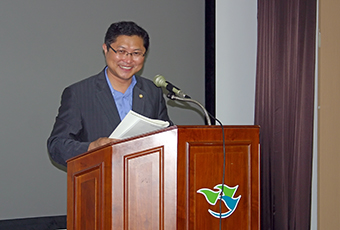 Mr. Kang Sung-Hwi, Vice-Chairman Mokpo City Council Photo © MNHM | 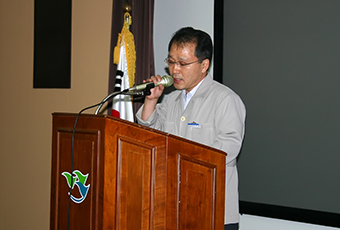 Mr. Jo Bu-Gab, Dirctor Mokpo Natural History Museum Photo © MNHM |
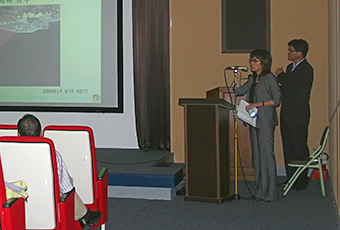 Ms. Park Meena, National Coordinator Birds Koera Photo © MNHM |  Mr. Graham White, RSPB UK Photo © MNHM |
 Mr. Graham White, RSPB UK Photo © MNHM |  Mr. Isoa Endo, UNDP/GEF Yellow Sea Project Photo © Birds Korea |
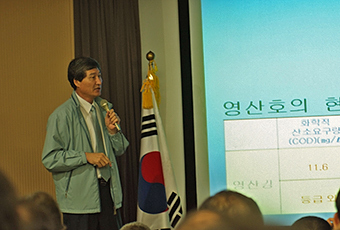 Prof. Chun Seung-Soo, Chonnam National University Photo © Birds Korea |  Dr. Hong Sun-Kee, Mokpo National University Photo © MNHM |
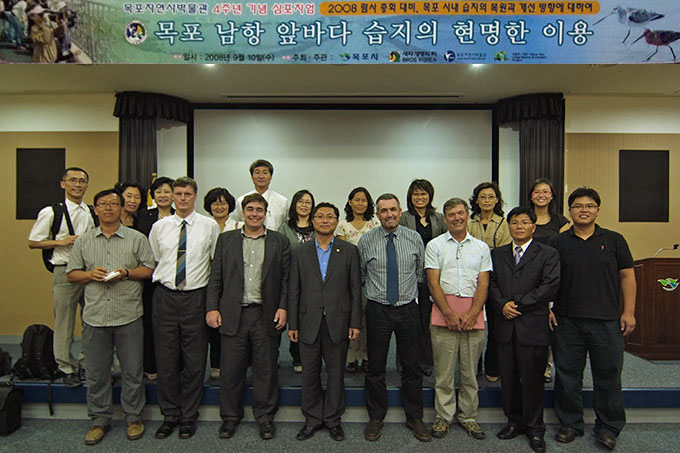 Participants who ensured a successful symposium, Photo © Birds Korea | |
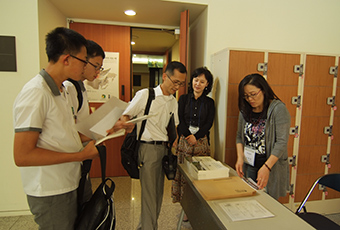 Visitors registering, Photo © Birds Korea | 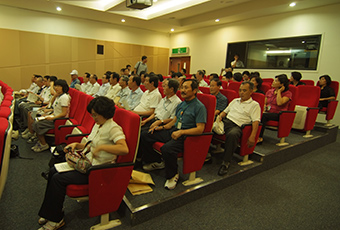 Waiting for the symposium to begin, Photo © MNHM |
 Students from Mokpo's Moontae High School with Birds Korea director Nial Moores and Prof. Chun Seung-Soo from Chonnam National University Photo © Birds Korea | |
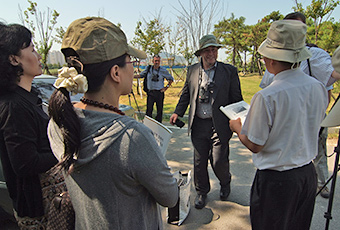 Preparation for the site visit Photo © Birds Korea |  Ms. Kim Sona (Birds Korea), Mr. Isao Endo (YSLME) and Mr. Graham White (RSPB), Photo © Birds Korea |
 Mr. Graham White explaining about the site, Photo © MNHM | |
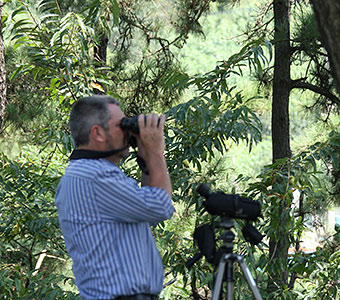 Mr. Graham White (RSPB), Photo © Birds Korea | 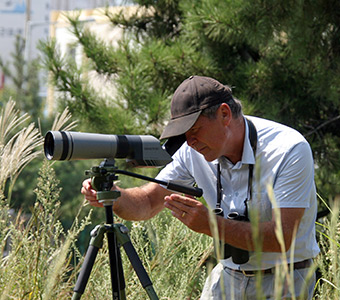 Mr. Martin Sutherland (UK), Photo © MNHM |
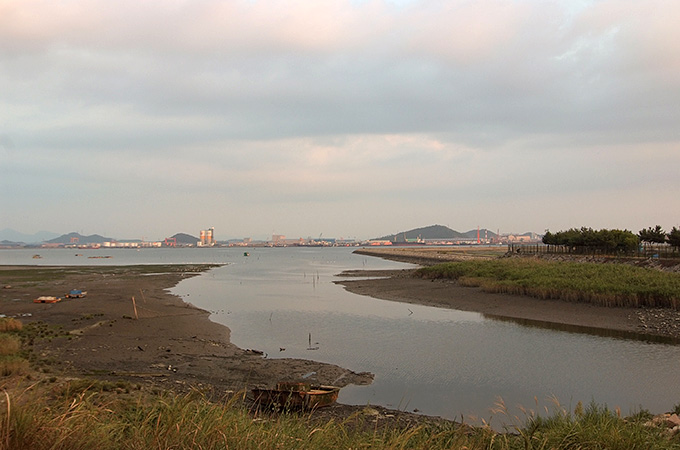 The Mokpo Namhang Urban Wetland, Photo © Birds Korea | |




